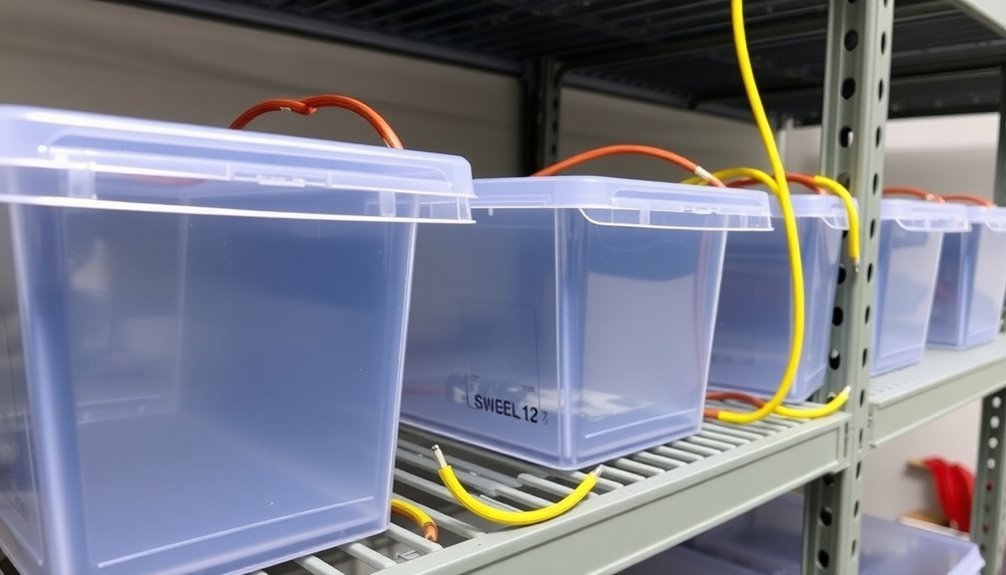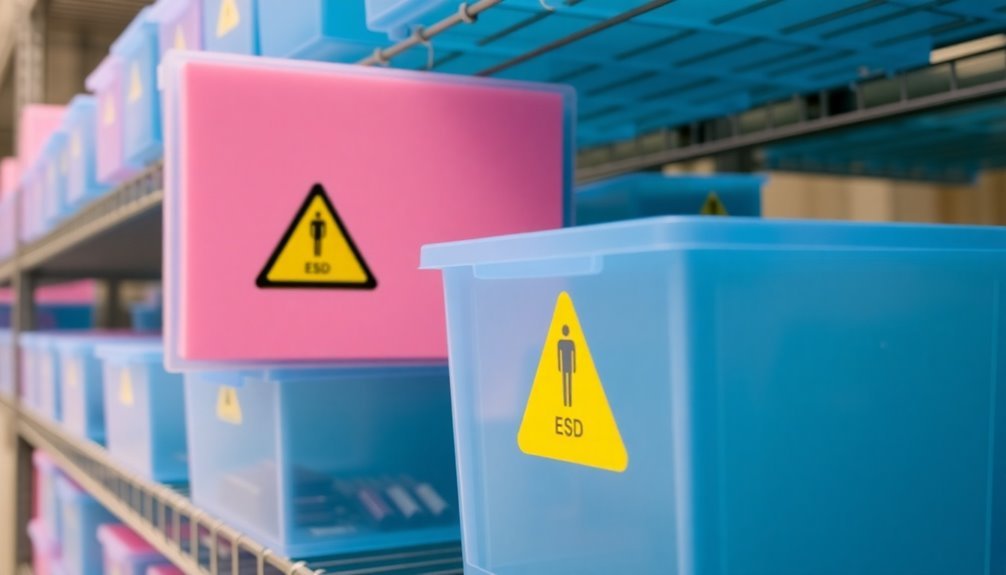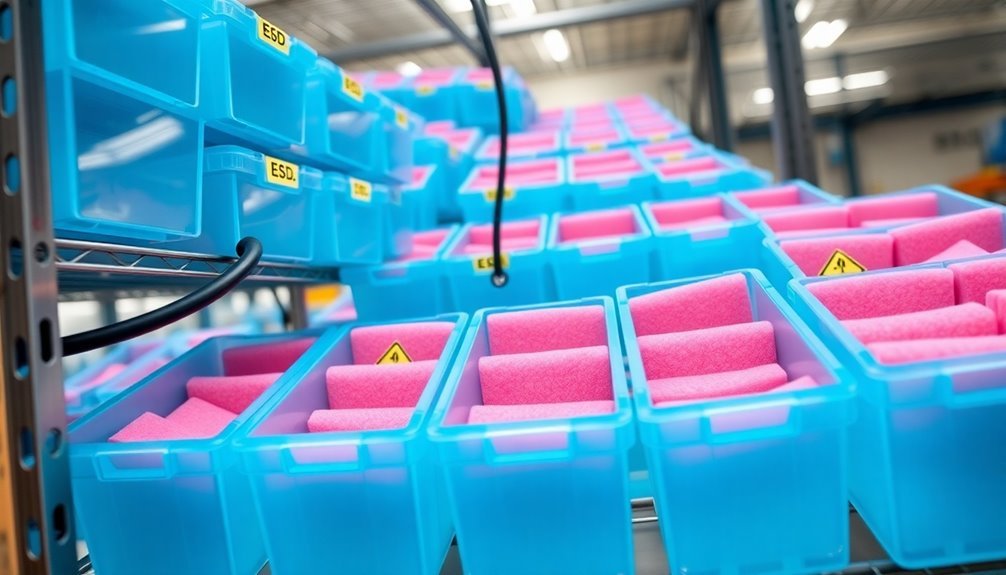To protect your sensitive electronic components in ESD storage bins, you'll need three essential measures. First, guarantee proper grounding by connecting your bins directly to a common ground point or placing them on a conductive work surface – both methods require regular testing. Second, organize components systematically using adjustable dividers and clear labels, while storing them in moisture barrier bags when needed. Third, verify your bins meet industry standards for surface resistivity (less than 10^12 ohms for anti-static, less than 10^5 ohms for conductive materials). Understanding these key principles will help you implement a thorough ESD protection system.
Proper ESD Bin Grounding Methods

Electronics' most vulnerable components require proper grounding methods to prevent electrostatic discharge (ESD) damage during storage. You'll need to connect your storage bins to a common ground point, which you can achieve through either direct or indirect grounding methods.
For direct grounding, attach your ESD bins to the common ground point using grounding cables. A current limiting resistor in the grounding cable provides essential safety protection.
If you're using indirect grounding, place your bins on a conductive work surface that's already connected to the ground point. Make sure you're using bins made of conductive or dissipative materials that meet the EN 61340-5-1 standards, with surface resistance between 1 x 10^4 and 1 x 10^11 ohms.
Don't forget to establish a complete grounding system. You'll want to implement ESD control flooring with appropriate footwear and use grounding wrist straps when handling components.
Identify your common ground point with the ANSI/ESD S8.1 symbol, and test your grounding equipment regularly.
To maintain effectiveness, keep your ESD-protected area clean and control humidity levels. Remember to store components only in ESD-safe containers that comply with industry standards.
Organizing Electronic Components Effectively
With your ESD protection measures in place, proper organization of components becomes your next priority. You'll want to categorize components by function, using clearly labeled storage bins with adjustable dividers to accommodate different sizes. Make sure you're implementing a standardized naming convention for easy identification and retrieval. Small electronic components should be stored in moisture barrier bags to prevent humidity damage.
| Component Type | Storage Solution | Environmental Need |
|---|---|---|
| Resistors | Compartmentalized trays | Temperature control |
| Capacitors | Totes with dividers | Humidity regulation |
| Transistors | Stackable containers | UV protection |
| ICs | Custom drawer inserts | Static prevention |
| Connectors | Storage racks | Proper ventilation |
For efficient organization, you'll need to utilize transparent storage containers whenever possible, allowing quick visual identification of components. Don't forget to maintain proper environmental conditions – keep your storage area temperature-controlled and regulate humidity levels to prevent ESD damage. You should regularly inspect your storage setup to guarantee components remain properly organized and protected. Consider using customized storage solutions based on your specific component types and quantities. Remember to keep your storage areas clean and free from dust, as debris can contribute to static buildup and potentially damage sensitive components.
Maintaining Static Protection Standards

Three critical standards govern effective static protection in your component storage: material selection, design specifications, and handling procedures.
For material selection, guarantee your storage bins meet surface resistivity requirements – anti-static materials should measure less than 10^12 ohms per square inch, while conductive materials should be 10^5 ohms or less. Your bins must comply with MIL-B-81705-B and EN 61340-5-1 standards for electrostatic protection. You can easily identify ESD containers by their color – anti-static bins are blue.
When selecting bin designs, opt for high-density polyethylene (HDPE) or black PP plastic containers that offer permanent anti-static properties. You'll need to verify that your containers maintain proper grounding capabilities and feature appropriate design elements like lids and dividers for component separation.
For handling procedures, you'll need to establish and maintain an electrostatic protected area (EPA) with proper grounding systems. Keep humidity levels above 15% when using anti-static materials, and regularly evaluate your static control measures.
If you're working in clean room environments, choose anti-static materials over conductive ones, as carbon black particles from conductive materials can slough off and contaminate the space. Remember to regularly assess your bins' surface resistance and shielding properties to guarantee ongoing compliance.
Frequently Asked Questions
Can ESD Bins Be Recycled When They Reach the End of Life?
Yes, you can recycle your ESD bins when they're no longer usable. They're typically made from recyclable polypropylene plastic, so just make certain you send them to proper recycling facilities that handle conductive plastics.
How Often Should ESD Storage Bins Be Tested for Conductivity Loss?
You should test ESD storage bins at least quarterly, but adjust frequency based on usage intensity, environmental conditions, and material degradation. More frequent testing may be needed if you handle highly sensitive components.
What Temperature Range Can ESD Storage Bins Safely Operate Within?
You can safely use ESD storage bins between -20°C to +100°C (-4°F to 212°F). However, you'll find Fibrestat boxes offer the widest range, from -60°F to 250°F, while maintaining their ESD protection.
Are Clear ESD Storage Bins as Effective as Colored Ones?
You'll find that clear and colored ESD bins are equally effective at protecting components. The bin's color doesn't affect its ESD properties – what matters is the conductive or dissipative material it's made from.
Do ESD Storage Bins Expire or Have a Recommended Replacement Timeline?
You don't need to replace ESD storage bins on a fixed schedule, as they don't technically expire. However, you should inspect them regularly for damage and perform annual testing to verify they maintain their protective properties.
In Summary
By following proper grounding methods, organizing your components systematically, and maintaining strict static protection standards, you'll create a safer storage environment for your sensitive electronic parts. Don't forget to regularly check your bins' ESD protection levels and keep them properly labeled. When you make ESD safety a daily priority, you'll protect your valuable components and avoid costly damage from static discharge.





Leave a Reply